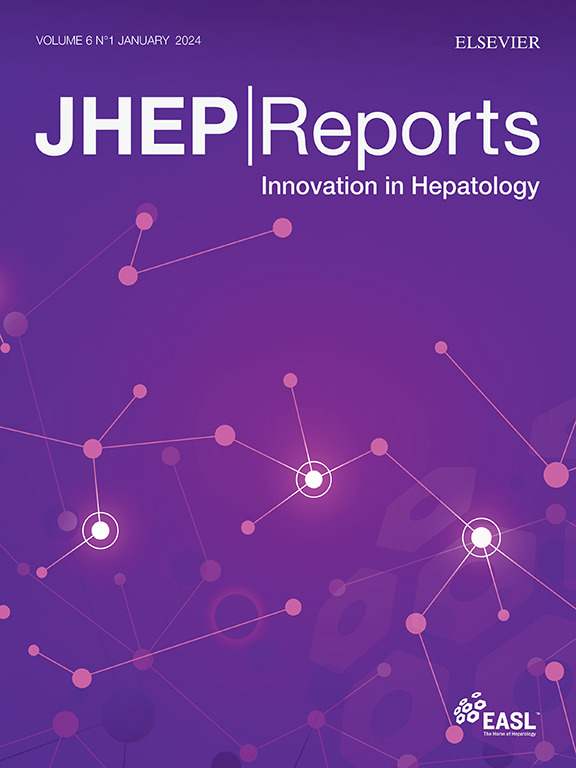Altered liver sinusoidal endothelial cells in MASLD and their evolution following lanifibranor treatment
IF 9.5
1区 医学
Q1 GASTROENTEROLOGY & HEPATOLOGY
引用次数: 0
Abstract
Background & Aims
Data on changes in liver sinusoidal endothelial cells (LSECs) in patients with metabolic dysfunction-associated steatotic liver disease (MASLD) and their response to treatment are limited. This study aimed at determining (i) features associated with LSEC capillarisation in patients with MASLD; (ii) whether LSEC changes can regress with the pan-peroxisome proliferator-activated receptor (PPAR) agonist lanifibranor; (iii) the role of the different PPAR isotypes on LSEC changes in MASLD.
Methods
We analysed CD34 expression, a marker of LSEC capillarisation, on liver biopsies from patients considered for inclusion in the NATIVE trial at baseline (n = 249), and after 24 weeks of placebo or lanifibranor (n = 173). Two rat models of MASLD were used to investigate the effect of lanifibranor or of mono-PPAR agonists on LSECs.
Results
Lobular CD34 staining was more intense in patients with isolated steatosis than in those with no MASLD (52% vs. 10%; p = 0.03). In the overall cohort, this staining was more intense in patients with metabolic dysfunction-associated steatohepatitis (MASH) than in those without (63% vs. 41%; p = 0.01) and strongly correlated with liver fibrosis and to a lesser extent with liver inflammation. Lanifibranor treatment was associated with more common improvement in CD34 periportal staining (p = 0.025), and less frequent worsening of lobular staining (p = 0.028). Compared with healthy rats, rats with MASLD had higher CD34 staining, portal venous pressure, intrahepatic vascular resistance, and impaired liver endothelial function. Lanifibranor normalised or strongly improved these abnormalities, whereas mono-PPAR agonists caused partial improvements.
Conclusions
In patients, LSEC capillarisation was increased at the earliest stages of MASLD and was associated with liver fibrosis and inflammation. In both patients and rats with MASLD, lanifibranor treatment was associated with improvement in liver endothelial phenotype.
Impact and implications
Data on changes in liver sinusoidal endothelial cells (LSECs) in patients with metabolic dysfunction-associated steatotic liver disease (MASLD) and their response to treatment are limited. This study demonstrates that LSEC capillarisation is already present in the lobular zone of the liver of patients and rats at the stage of isolated steatosis, before metabolic dysfunction-associated steatohepatitis (MASH) onset, and progresses with liver fibrosis, and to a lesser extent with liver inflammation. Lanifibranor treatment, a pan-peroxisome proliferator-activated receptor agonist currently tested in a phase III clinical trial, improves LSEC capillarisation but also intrahepatic vascular resistance and portal pressure in MASLD. Targeting LSECs appears to be a promising approach to improve MASH.

MASLD患者肝窦内皮细胞的改变及其在兰菲诺治疗后的演变
背景,目的:关于代谢功能障碍相关脂肪变性肝病(MASLD)患者肝窦内皮细胞(LSECs)变化及其对治疗反应的数据有限。本研究旨在确定(i)与MASLD患者LSEC毛细血管化相关的特征;(ii) LSEC的变化是否会随着泛过氧化物酶体增殖物激活受体(PPAR)激动剂lanifbranor而消退;(iii)不同PPAR同型对MASLD中LSEC变化的作用。方法:我们分析了考虑纳入NATIVE试验的患者在基线(n = 249)和服用安慰剂或兰尼布诺24周(n = 173)后的肝活检中CD34的表达,这是LSEC毛细血管化的标志物。采用两种MASLD大鼠模型,研究lanifbranor或单ppar激动剂对LSECs的影响。结果孤立性脂肪变性患者的颞叶CD34染色比无MASLD患者更强烈(52% vs. 10%;P = 0.03)。在整个队列中,代谢功能障碍相关脂肪性肝炎(MASH)患者的这种染色比没有代谢功能障碍的患者更强烈(63%对41%;P = 0.01),与肝纤维化密切相关,与肝脏炎症程度较低。兰菲布诺治疗与更常见的CD34门静脉周围染色改善相关(p = 0.025),小叶染色恶化的频率更低(p = 0.028)。与健康大鼠相比,MASLD大鼠CD34染色、门静脉压、肝内血管阻力升高,肝内皮功能受损。兰尼布兰诺使这些异常正常化或强烈改善,而单ppar激动剂只引起部分改善。结论在MASLD患者中,LSEC毛细血管化在早期阶段增加,并与肝纤维化和炎症有关。在MASLD患者和大鼠中,兰菲布诺治疗与肝内皮表型的改善有关。影响和意义代谢功能障碍相关脂肪变性肝病(MASLD)患者肝窦内皮细胞(LSECs)变化及其对治疗反应的数据有限。该研究表明,在分离性脂肪变性阶段,在代谢功能障碍相关脂肪性肝炎(MASH)发病之前,LSEC毛细血管化已经存在于患者和大鼠的肝脏小叶区,并随着肝纤维化进展,在较小程度上与肝脏炎症有关。Lanifibranor治疗是一种泛过氧化物酶体增殖物激活受体激动剂,目前正在III期临床试验中测试,可改善MASLD的LSEC毛细血管化,但也可改善肝内血管阻力和门静脉压力。以LSECs为目标似乎是改善MASH的一种有希望的方法。
本文章由计算机程序翻译,如有差异,请以英文原文为准。
求助全文
约1分钟内获得全文
求助全文
来源期刊

JHEP Reports
GASTROENTEROLOGY & HEPATOLOGY-
CiteScore
12.40
自引率
2.40%
发文量
161
审稿时长
36 days
期刊介绍:
JHEP Reports is an open access journal that is affiliated with the European Association for the Study of the Liver (EASL). It serves as a companion journal to the highly respected Journal of Hepatology.
The primary objective of JHEP Reports is to publish original papers and reviews that contribute to the advancement of knowledge in the field of liver diseases. The journal covers a wide range of topics, including basic, translational, and clinical research. It also focuses on global issues in hepatology, with particular emphasis on areas such as clinical trials, novel diagnostics, precision medicine and therapeutics, cancer research, cellular and molecular studies, artificial intelligence, microbiome research, epidemiology, and cutting-edge technologies.
In summary, JHEP Reports is dedicated to promoting scientific discoveries and innovations in liver diseases through the publication of high-quality research papers and reviews covering various aspects of hepatology.
 求助内容:
求助内容: 应助结果提醒方式:
应助结果提醒方式:


